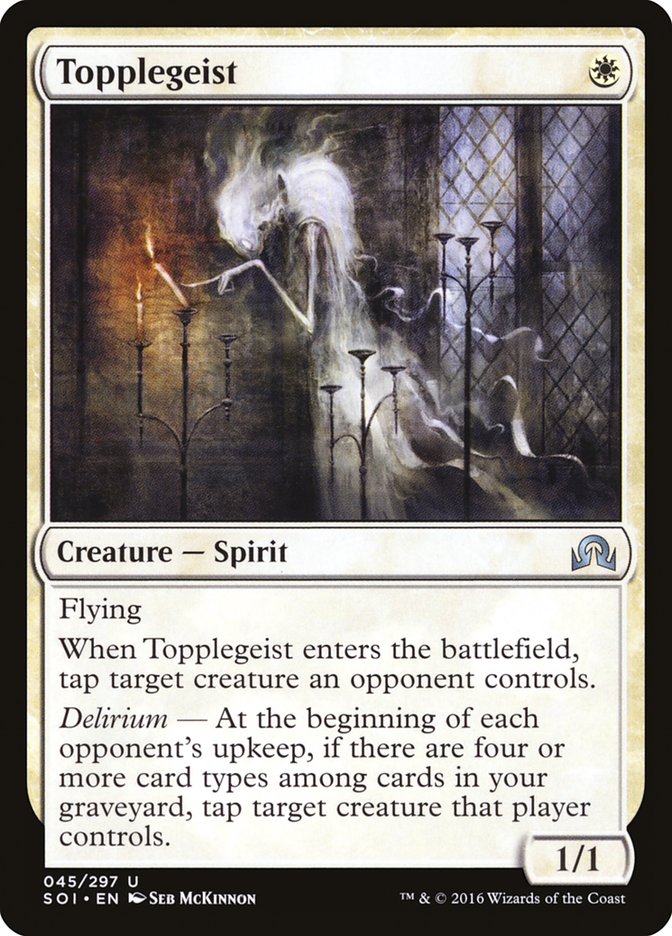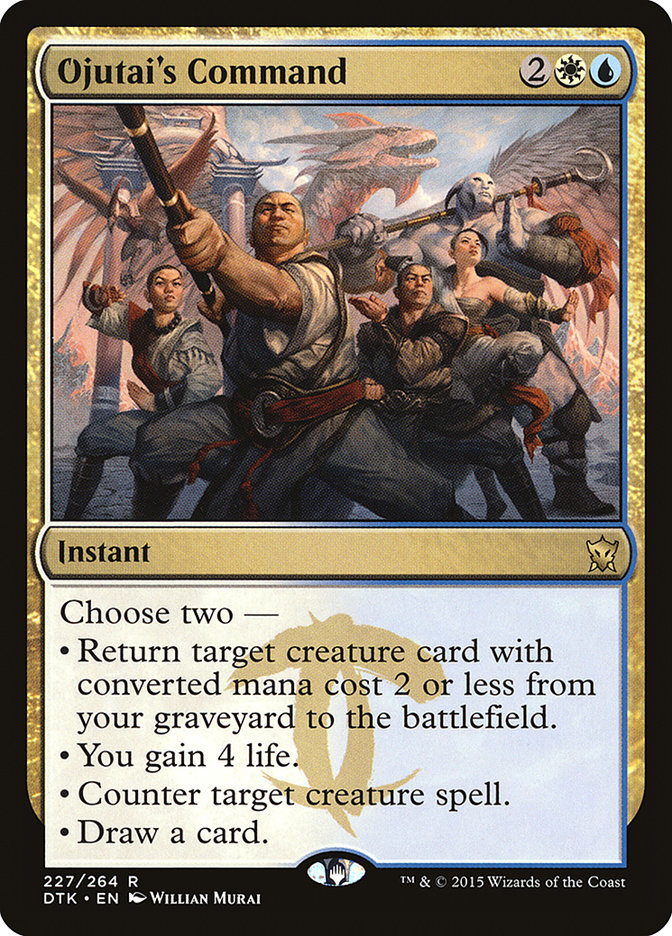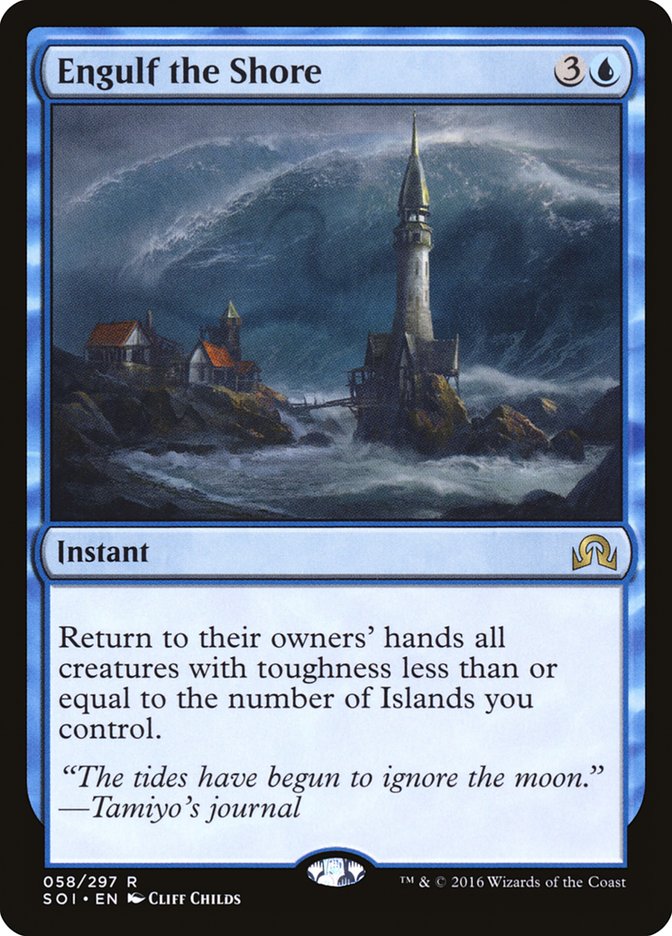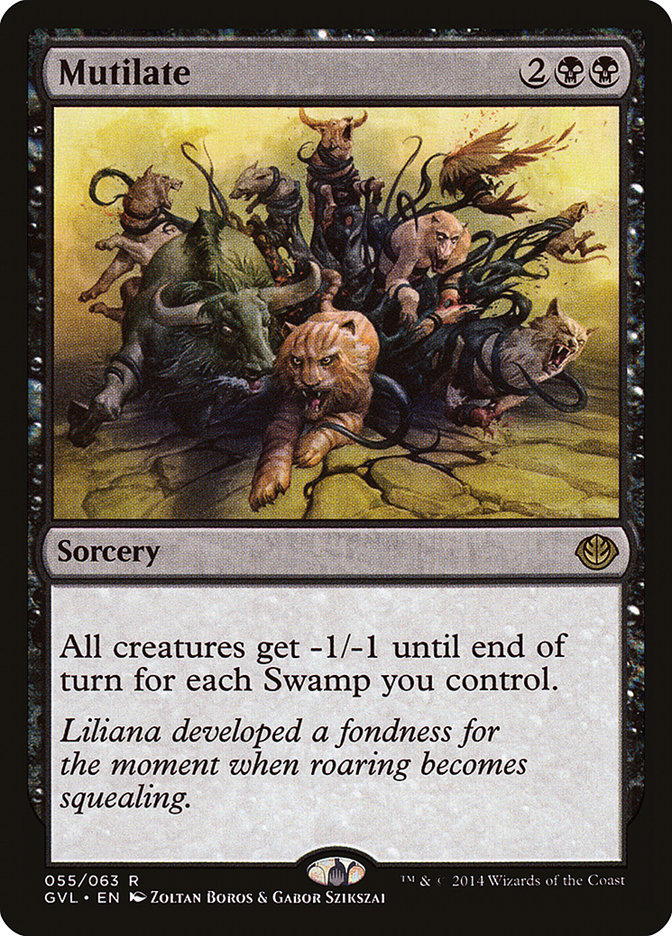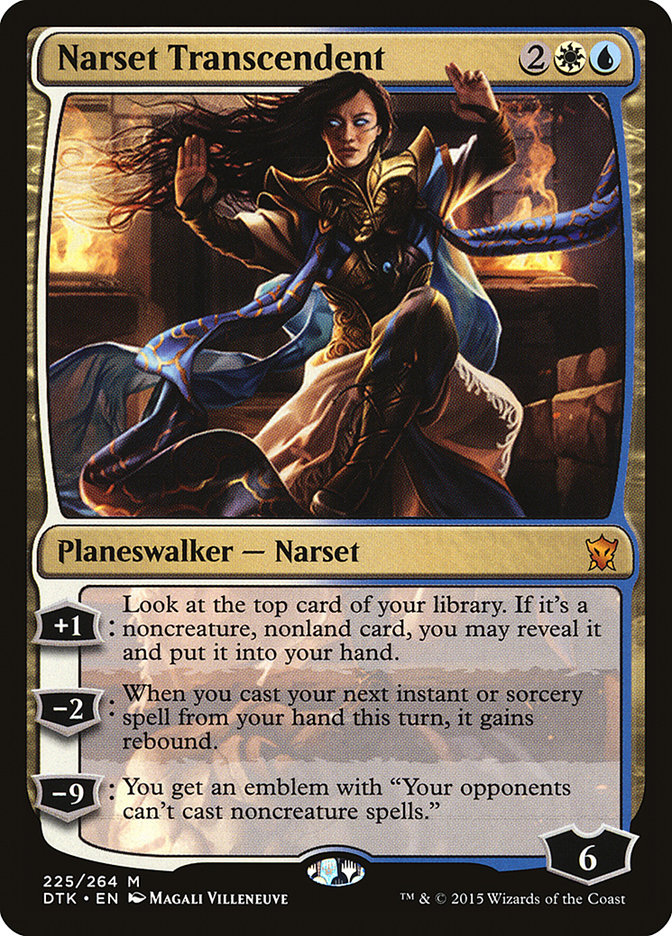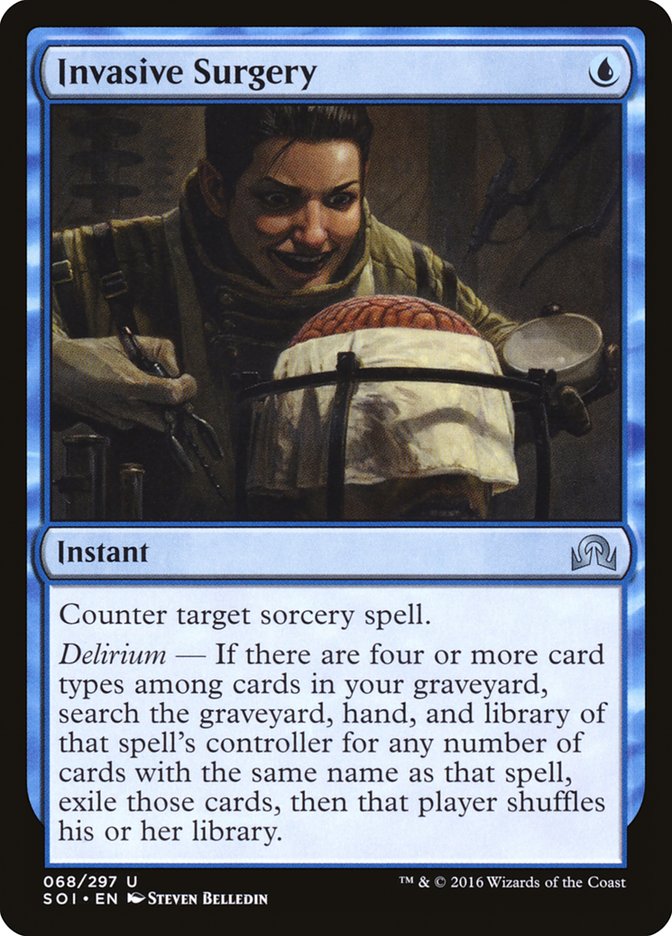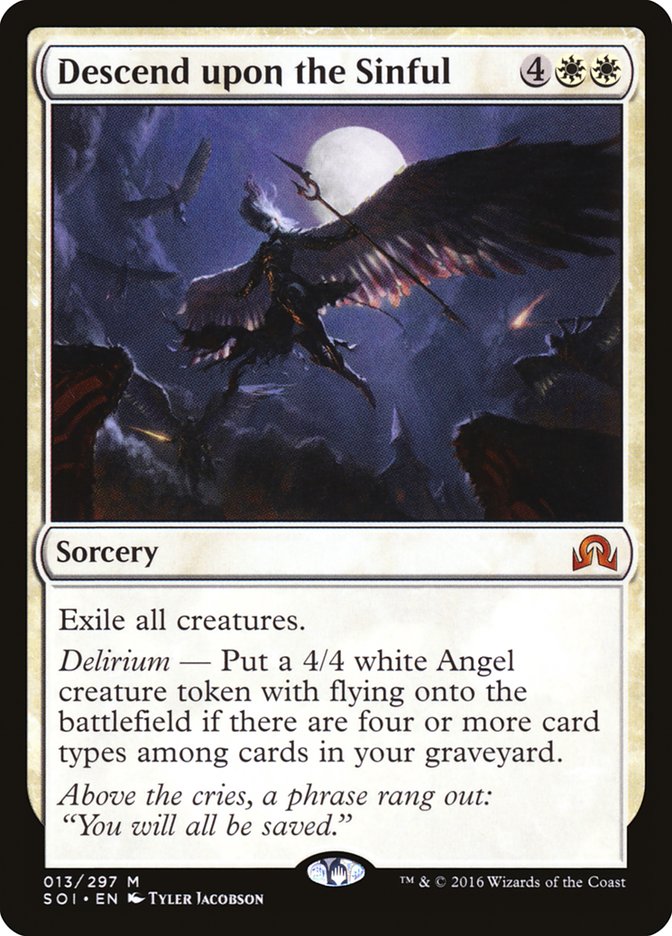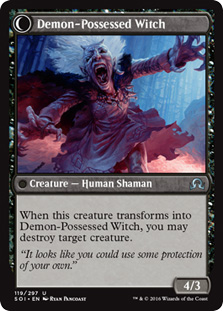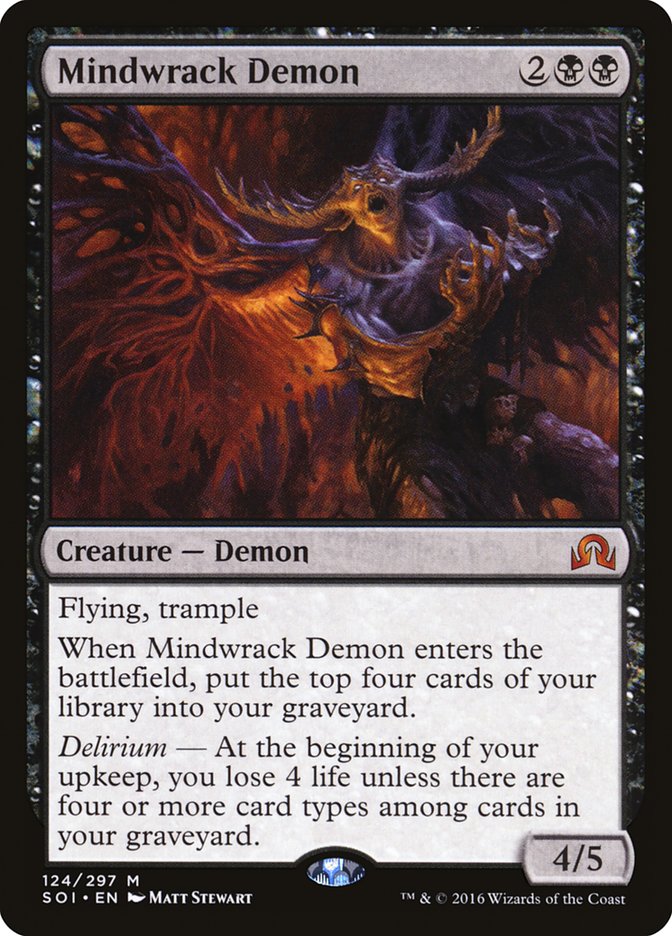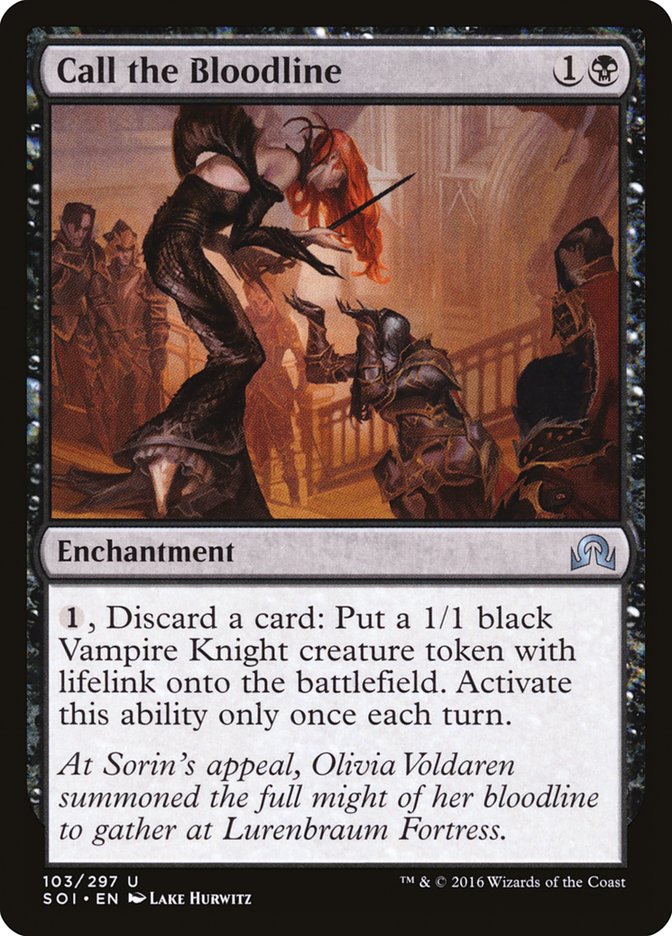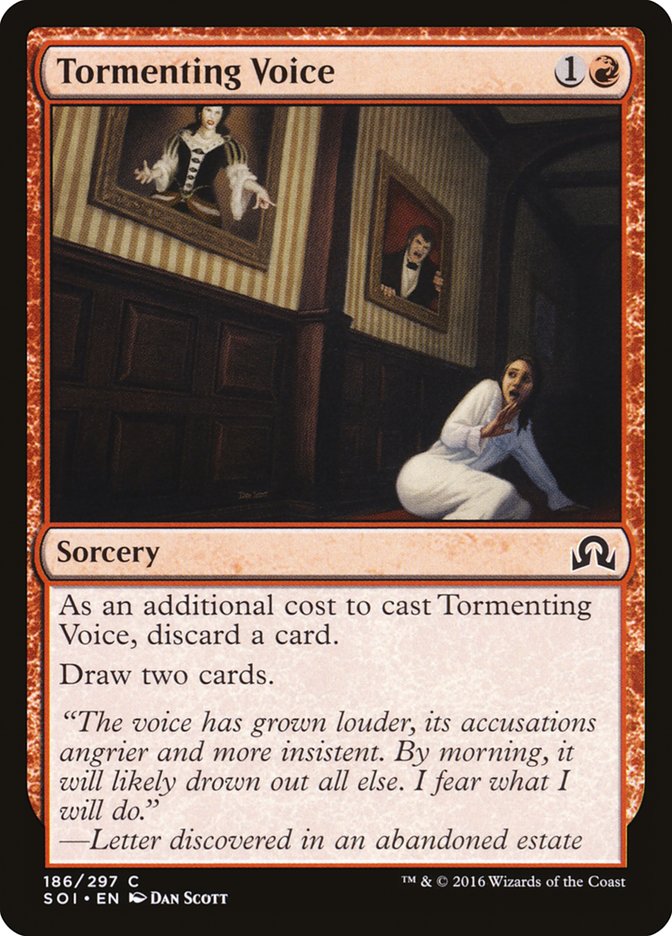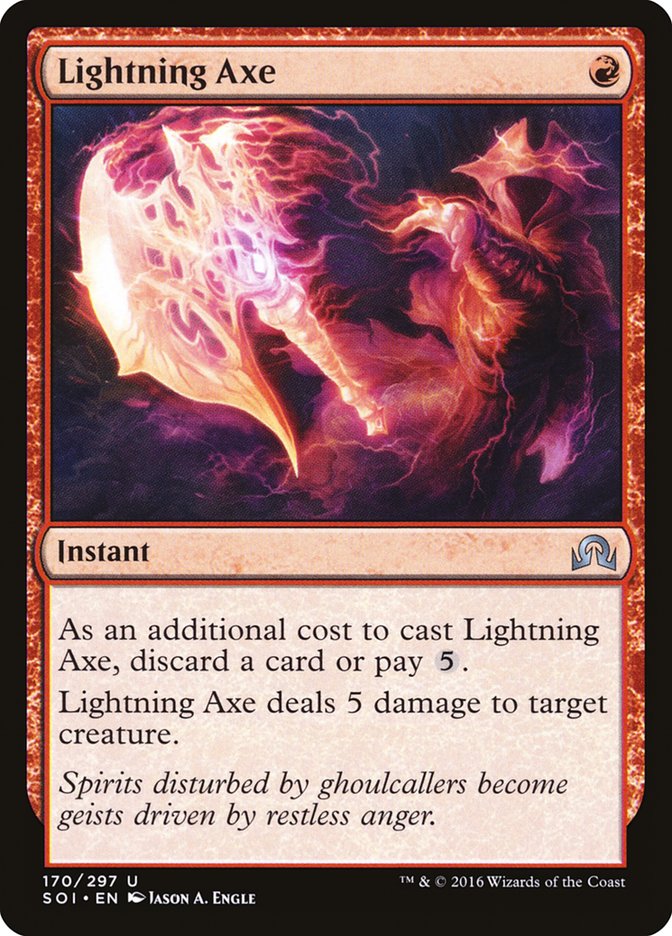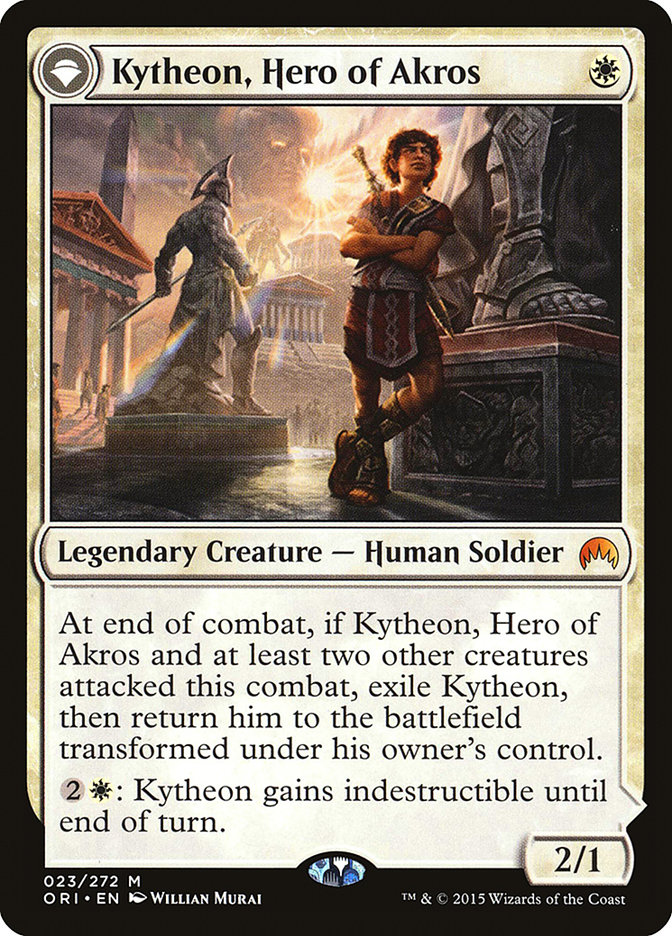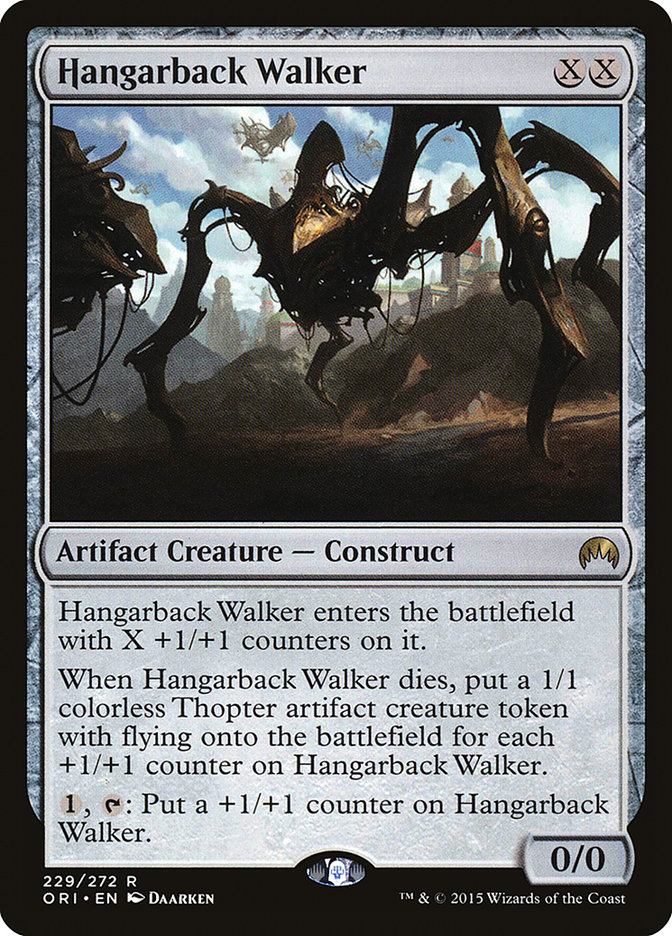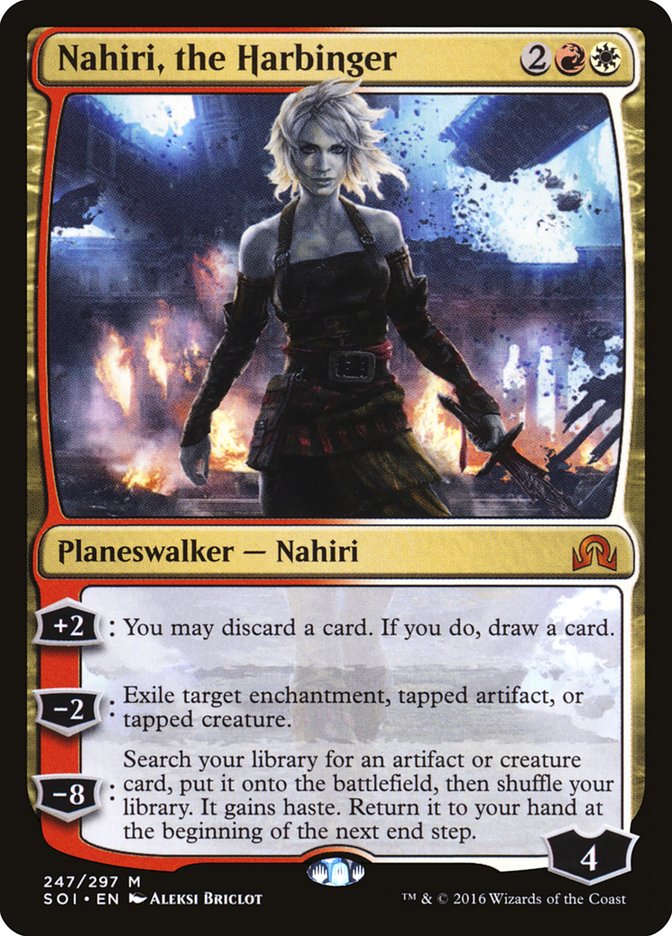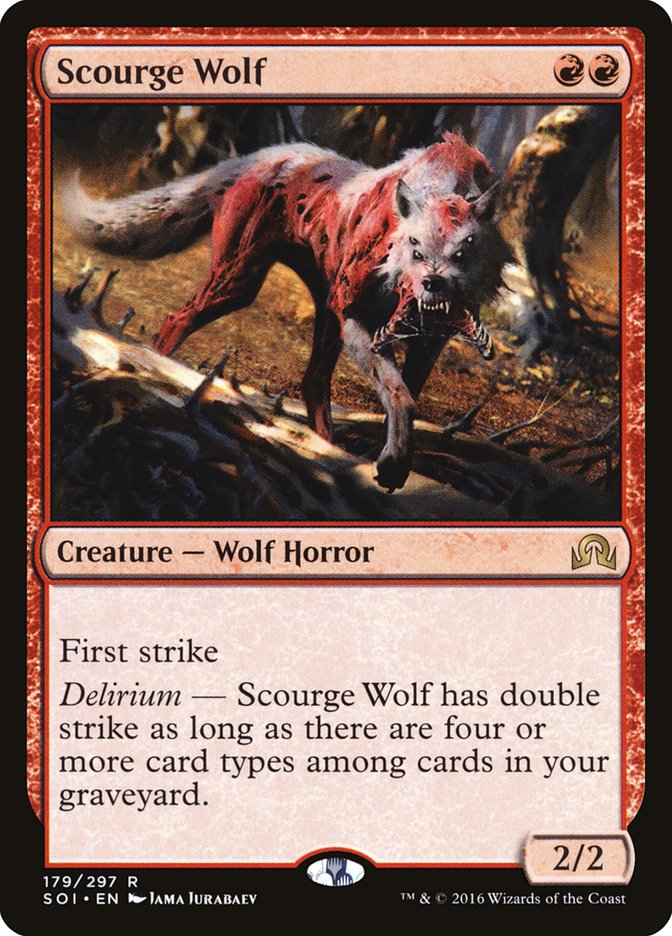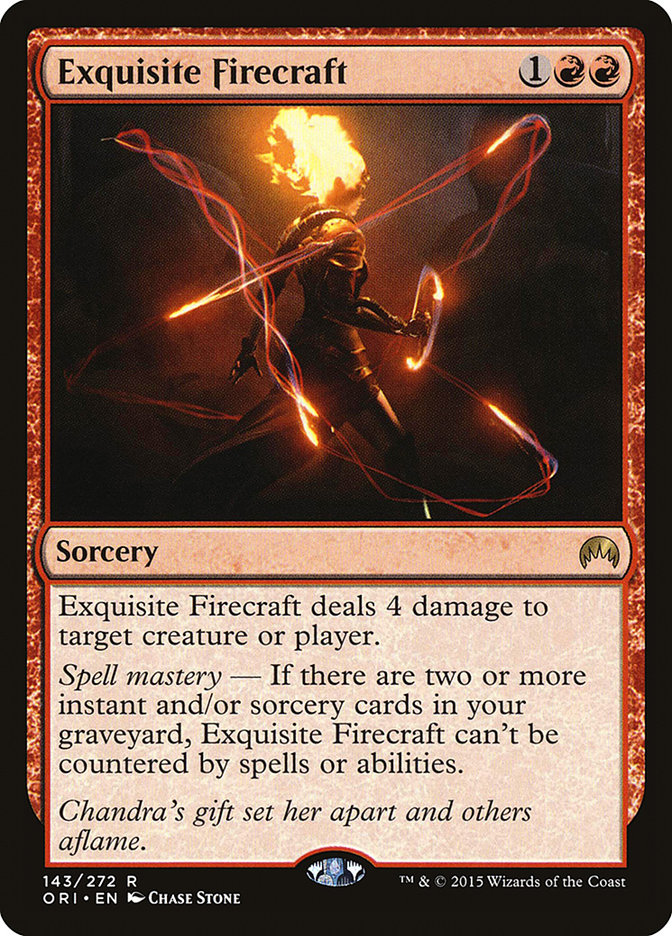Some of the best delirium spells from Shadows over Innistrad displayed their flavor, utility, and efficiency in last week’s article, and this week, we’re back for another helping of wild and crazy decks! This graveyard-matters mechanic excites every part of the structuralist side of Magic that I enjoy. With all of the enablers, undercosted effects, and potential for wild interactions that delirium and its infrastructure offers, I couldn’t stop with just a couple decks to cover the mechanic. Last week, I promised you three decks to continue that theme, and we’re back where we left off.
Last week, Topplegeist featured as a prominent, constant removal spell with wings in my Bant Autumnal Gloom deck. Topplegeist did so well, I wanted to play with it again. But how?
Manic Scribe hasn’t gotten any airtime yet, mostly because it’s great at milling your opponent and not much else. At 0/3, its stats aren’t super, and if you’re not on the mill plan, you could go so far as to help your opponent reach delirium or give them Den Protector targets. At best, this card is a slightly softer Mind Sculpt that blocks. At worst, it’s a powerless speedbump.
It does trigger when it enters the battlefield, like Topplegeist, so if there were a way to rebuy it, I think I could get a bit more interested.
Oh, well, there you go.
Creatures (8)
Planeswalkers (4)
Lands (23)
Spells (25)

The deck features an old favorite of the mill plan in Standard: Sphinx’s Tutelage. Combined with considerable draw power, the fact that it’s an enchantment, and the snowball effect multiples of the card can have, there’s always going to be potential for it. On top of the delirium plan, we’re focusing on drawing cards, bouncing creatures, and staying alive long enough to see them turn that last card over from their library.
Topplegeist and Manic Scribe can both be reanimated with Ojutai’s Command, meaning you can discard, mill over, or block with either and get it back later. While Hangarback Walker has been great in other builds, it and its tokens will get bounced or destroyed at the first opportunity, mostly by the machinations of this deck.
As is the case with most control decks, preserving your life total is important, and these creatures and Ojutai’s Command fill that role perfectly. Anticipate and Nagging Thoughts are a bit pedestrian, but with a deck full of specific threats and answers, this is as easy a way as any to fill your graveyard with spells or whatever card types you need.
With just one basic Plains and eighteen Islands (and four ways to search for either), you’ve got a red flag for Engulf the Shore.
If you’ve ever cast Mutilate, you know how bad it is when you don’t have four Swamps on turn 4. You Mutilate and you get some of the little creatures, but that big nuisance is still there, ready to bash you the next turn while your would-be blockers get stacked in your graveyard. Thus, we have to be deep on Islands.
Send to Sleep is a little more innocuous, but a good Nagging Thoughts can get you ready for spell mastery all by itself. This deck is all about buying time, and this is a solid deposit. While I’d love to play cards like Declaration in Stone and Planar Outburst, this is what our removal has to look like when we’re full on Islands.
Narset Transcendent is the deck’s bullet, and one of the best reasons to add a little white. Narset can double up any spell, whether it’s a bounce spell like Engulf the Shore or a draw spell like Nagging Thoughts, allowing you to fill your graveyard with more kinds of spells and lands. Her +1 has plenty of targets, too, 25 if you don’t include her. While four might seem like a lot of copies, she can slowly give you advantage or threaten to dominate the game. She can split your opponent’s offense, too, which will get you more time to find your Sphinx’s Tutelage.
Sphinx’s Tutelage and the accompanying Oath of Jace work well together, the latter providing three triggers for the former, and as we saw in the Bant deck last week, Oath of Jace can provide you easy ways to empty those critical delirium cards into your graveyard.
One quick note on the sideboard.
There are only two blue delirium cards, and this one is perhaps the more powerful one. Decks like this one can fall prey to Duress, Transgress the Mind or any other number of targeted hand disruption spells, and this counters it. The way it reads, you can even fish out Exquisite Firecrafts, even if it’s not countered due to spell mastery. This is the bullet you need to stop control decks from messing with you on the cheap.
In practice, this deck is a bit…weird. It’s not a great mill deck, with only eight cards out of sixty designed to close the game, but it’s surprisingly good at protecting itself. Nagging Thoughts was a very respectable delirium enabler, and I found myself copying it with Narset frequently. Did you know you can rebound spells three times with Narset before she’s out of loyalty counters? That’s so many times! While this deck was pretty fun, it wasn’t quite delirium-y enough. It didn’t need it, though Manic Scribe turned out to be super.
I needed more hard removal; blue was not meant to be a delirium color, despite the enablers available to it. White has hard removal, and in fact, one of the strongest delirium spells in Shadows over Innistrad is white: Descend upon the Sinful.
This is Final Judgment with a big upside: an evasive 4/4 token that enters the battlefield right after everything has been wiped out. Your opponent can’t block it or pressure you back; they go on defense.
Black has plenty to be proud of in the delirium category, so let’s pair them and see where it goes.
Creatures (16)
Planeswalkers (3)
Lands (24)
Spells (17)

This feels much more like a control deck. To be honest, I’m happy that this Standard and Oath of the Gatewatch Standard featured strong B/W control and midrange decks. No blue required!
Sanitarium Skeleton seems pretty weak and, well, it is. It’s an Eager Cadet that you can rebuy, but for a deck like this, we’re looking for long-term value. Two of these can block most early drops and trade up, and the Skeletons are flexible. They can chump block endlessly, function as discard or sacrifice fodder, or provide a hard-to-remove, albeit weak, threat against control. With Gideon’s emblem, they become much more respectable 2/3s for one, and every extra copy makes it all the better. Hangarback Walker and Topplegeist are back, and we get to welcome a newcomer. Oh look, it’s a Kindly Stranger.
Oh my.
Seriously, though, this is a Shriekmaw. Remember how good that card was? Kindly Stranger and its sinister flipside may not have evasion, but 4/3s are great in a metagame of 2/3s like Sylvan Advocate and Reflector Mage. This card has a lot of power in it, and its exceptional flexibility of “play me as a 2/3” or “play me for six and kill something” means you’ll be pretty happy to have one at most points in the game.
Mindwrack Demon is great, but its softness to cards like Ultimate Price and Collected Company staples like Bounding Krasis, combined with its potentially awkward upkeep trigger, makes it more of a liability. While clearly powerful, it can be fetched up with Corpse Churn.
Corpse Churn is a great black delirium enabler, again, because of its flexibility. You can main-phase it to try to find a relevant creature or keep removal mana up until the coast is clear to cast it on the end step. I can even imagine not picking up a creature if doing so would ruin delirium. If you have an empty graveyard, you can cast this instant, hit a creature, sorcery, and a land, and be set right there!
Most of the other spells are standard fare these days: Ultimate Price still feels like exactly the removal you want, and Read the Bones is a sorcery that filters your deck to find those great madness cards.
I have been testing this card for a while in multiple control builds, and I have been really happy with it. It’s great as an enchantment for delirium, but if you’ve got lots of mana and Sanitarium Skeletons, you can make an army every turn. This card can hold your opponent off with a stream of blockers, it can enable delirium at instant speed, or it can slowly turn the chaff you draw into pressure your opponent will now have to deal with. Just remember to save an Ultimate Price in case they attempt to Declaration in Stone one of your Vampires!
Except for four Drownyard Temples, the manabase is as you might expect with a healthy dose of Evolving Wilds to thin your deck and add lands to the graveyard.
This deck played the widest game of all the delirium lists I’ve tested, both before and since. That is, it can do the most at any one time. There were lots of decisions to make, and I always felt like I was within reach of the answer I needed. While the mana proved a bit clunky, I found myself with sufficient offense and defense within the deck.
Kindly Stranger was awesome in this build, and it outshined even Topplegeist as a hard answer and continuous pressure. It was a little slow, but the deck never felt assaulted, even by heavy aggro decks like Mono-White Humans. The numbers may not have been quite right (most likely fewer/better creatures), but the removal and delirium possibilities were really strong. Descend upon the Sinful felt great, but it was a bit too slow to compete for the same slots as those emergency sweepers like Languish.
Topplegeist probably has one more deck in it, and if it does, it might be binned alongside this.
You know this card. Chances are you’ve gotten smacked with a Human blessed by this Boon a time or two as you felt stable with a few points of life. It does a great job while suited up, but it also counts towards delirium in the graveyard with the less-than-common enchantment card type.
This time, we’re moving toward red. While red doesn’t have mass graveyard fillers like blue, black, and green, red does have targeted graveyard filling through discard. This is better in many ways, allowing skill to play more than luck, and in that vein, it seems like the best color to pair with white for aggressive reasons, too.
Creatures (20)
- 3 Kytheon, Hero of Akros
- 1 Pia and Kiran Nalaar
- 4 Hangarback Walker
- 3 Reckless Bushwhacker
- 4 Topplegeist
- 1 Paranoid Parish-Blade
- 4 Scourge Wolf
Planeswalkers (4)
Lands (22)
Spells (14)
Sideboard

This should all be familiar to you now; Lightning Axe and Tormenting Voice act as our enablers this time, and they do a great job of putting whatever you don’t need right into the graveyard, usually in exchange for something better, whether that’s an efficiently dead creature or another, more relevant card. Reckless Bushwhacker has fallen out of the spotlight lately, but I still think turn 1 Kytheon, Hero of Akros into turn 2 Hangarback Walker, turn 3 Topplegeist plus Goblin Bushwhacker feels pretty awesome.
A couple of standouts…
Paranoid Parish-Blade might just be a French vanilla, but four power is a lot on a three-drop in white, and especially with first strike. That thing can block like a pro or get sideways through blockers to pack a wallop. It knows it’s going to take something down. Don’t want a bunch of them, but it plays an efficient combat role.
Pia and Kiran Nalaar provide an opportunity to crack my Hangarback Walkers on demand, but they’re also a nice target for Nahiri, the Harbinger’s ultimate. Because her other modes are great, if I’m using her ultimate, it’s because I need to deal with more than one thing this turn. Thus, get Pia and Kiran Nalaar, make two 1/1 Thopters, return the power couple, and play them again for a wide field. Corrupted Grafstone is an easily sacrificed or discarded artifact for delirium, or it can help get you to a turn 3 planeswalker or a turn 4 Needle Spires attack, something most red and white decks can’t do.
The deck played out fairly well, and the planeswalkers were all outstanding, Nahiri being the most surprising. She plays very well, especially onto a battlefield that can protect her, and Gryff’s Boon turned out to be nuts. I didn’t need direct damage like Fiery Temper as much as I thought. I could suit up a Needle Spires or a Scourge Wolf and finish the job myself.
I promised you three decks, but this didn’t quite feel like the strong finish. I still feel like there were some outlets I didn’t quite cover. With this last deck, I’d I set out to make an aggro deck and what I really made was a midrange deck. Yes, Delirium seems to be immune from going a truly aggressive route.
This pup had a lot to say, and it was really efficient. A deck like this last one could have played Iroas’s Champion, but this two-mana double striker was the real deal.
Maybe there’s only one way to do it: cast off all the fancy and move just into aggression. Lots of fire, lots of heat, lots of hurry. Crank it up! Mono-red!
Creatures (21)
- 4 Lightning Berserker
- 1 Zurgo Bellstriker
- 4 Hangarback Walker
- 4 Gibbering Fiend
- 4 Scourge Wolf
- 4 Insolent Neonate
Lands (18)
- 18 Mountain
Spells (21)
- 4 Fiery Temper
- 4 Lightning Axe
- 1 Tormenting Voice
- 4 Infectious Bloodlust
- 4 Exquisite Firecraft
- 4 Skin Invasion
Sideboard

What a lovely day!
This deck has one job: get sideways and do it with a lot of power. Remove their blockers, sacrifice resources for efficiency, and get them dead.
Scourge Wolf is aggressively costed, and it’s easy to get delirium turn 3; slap an Infectious Bloodlust on it and you’re crashing for eight. Insolent Neonate has everything this deck wants: efficiency, evasion, and alternative modes. He takes pumps very well, but he’s the most utility creature I’ve ever seen for one red mana.
Gibbering Fiend can ping and ding your opponent to death once they’ve got their blocking force established. It’s a Shock that blocks! Skin Invasion, especially when placed on an Insolent Neonate that you then sacrifice, is a very efficient body for the cost, and you can force your opponent’s creature to slam into Hangarback Walker, breaking it open. Exquisite Firecraft is the best burn red has anymore, and a couple of these little numbers will put any wounded player under.
There’s also something great about just “eighteen Mountain” for a manabase.
The deck plays pretty quickly, but it’s a bit clumsy to do more than ten to fifteen points of damage before petering out. Mono-Red will probably be in a slump for a while without something like Lightning Strike. Maybe next set.
You know what else I hope is in the next set? More delirium!
These were all fun to plot out, build, and test. Which was your favorite? Which needs work? Where can we push delirium, maybe even in Modern and Legacy?


